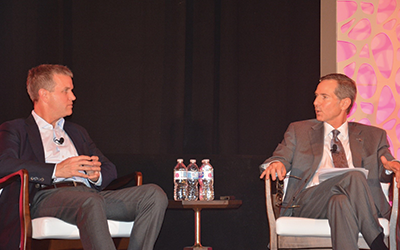NAI Global Chairman and NAI Global President Discuss the State of the Commercial Real Estate Market at NAI Global Convention

Geoffrey Woodward (left), NAI Global Chairman & C-III Capital Partners Senior Managing Director, recently spoke with NAI Global President Jay Olshonsky (right), SIOR, FRICS on the State of Commercial Real Estate before a full ballroom at the Hilton Austin Hotel with over 625 attendees. The following are excerpts from that discussion.
Woodward began by saying America’s household wealth has returned since the recession: “The U.S. residential market is valued at twice of what it was 8 years ago.”
Olshonsky stated that “everybody wants to know how much longer this market could last,” and Woodward replied that he didn’t see a particular timeline for the economy to tilt negatively, though he conceded that “real estate is a little over-valued at the moment.”
Olshonsky: “What’s the tipping point?”
Woodward: “The long-term capital markets are still attracted to gateway cities for investment and growth states in general. If there is a tipping point, it would be the rampant return of bad lending habits, too many leveraged loans and poor debt structures. Those are the canaries in the coal mine.”
He added that the percentage of ecommerce sales will continue to grow from its current 25 percent of retail sales to 35 percent or 40 percent in three or four years, excluding food and gas, “which isn’t necessarily a tipping point as much as it will just be more adjustments for people in the retail and distribution industries to make for the foreseeable future.
“Conversely, ecommerce has put a lot of wind in the sails for industrial real estate. Walmart’s sales from warehouse space have doubled in just a few years, for example,” Woodward said.
The two business leaders also discussed technology in commercial real estate and how it will continue to play an integral role in managing CRE businesses including transaction management.
“Real estate technology is actually more mature as a business than many people give the space credit. CoStar is a $15 billion business, for example. REthinkCRE and Apto seem to have established opportunity in the CRM space. Some of these businesses have excellent strategies, though I would caution that with software, it’s hard to develop, harder to sell, and hardest to make a profit.”
On the investment market, Olshonsky stated that more and more capital seems to be chasing the same space and in this kind of climate, he asked if it is possible to get decent returns on value-added deals.
Woodward said: “A lot of large institutional owners, including us, are starting to harvest returns on our real estate portfolios and that going forward, non-gateway cities are going to drive the market. Yet net-net, it is going to be harder to generate returns given the historically low cap rates – with industrial in the low 4s, hospitality in the high 7s and every other property sector in between.” C-III Capital Partners manages $12 billion in real estate assets.